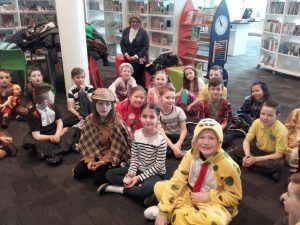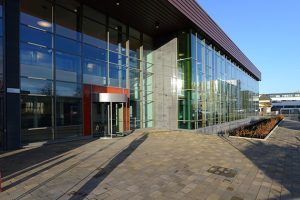The current context for community regeneration significantly restricts the resources available to place-based regeneration initiatives. In this contribution, Ken McKinlay argues that Scotland’s public libraries, regularly overlooked by the regeneration community, offer a wealth of potential and assets that can be effectively aligned with town centre action plans and other strategies.
It is a regeneration truism that it is about much more than physical infrastructure. It is about people, what they do, how they live their lives, the opportunities they have. It is about jobs, housing, education, health, culture.
And it can – and should – also be about libraries. Why libraries?
A Broadening Remit

Digital access and training has emerged alongside book borrowing as a key modern public library service
Early in 2016, CILIPS, the body for librarians in Scotland, published its manifesto, Inspiration for the Nation. It was aimed at candidates in the May Holyrood election but its message is more long-lasting than that. The manifesto sets out clearly and simply the contributions that libraries make to the major policy outcomes for Scotland – in inclusion, literacy, equality, employability and wellbeing.
Libraries provide spaces and activities for learning; they promote reading in young children, supporting attainment in later years, encouraging parent/child bonding – and giving a lot of pleasure in the process. They work with partners to provide information and advice.
 The Carnegie Trust publication Speaking Volumes sets out the sort of thing libraries do and the contributions they make.
The Carnegie Trust publication Speaking Volumes sets out the sort of thing libraries do and the contributions they make.
Virtue and Value
Because of this range of contributions, funding for libraries represents a remarkably good use of public money – up to £8 return on every £1 invested.
The Chief Executive of the Joseph Rowntree Foundation, Julia Unwin, spoke recently about the importance of creating social capital in cities, although, as she said, the principles apply beyond metropolitan areas. Libraries are key contributors to social capital and it can be argued that is their primary role in regeneration.
Accessible, neutral spaces in communities, they give opportunities for meeting, sharing, and building contacts; the knowledge and information they provide builds capacity and empowerment. Work spans the generations and brings them together. For example, young people can use library facilities to pass on IT skills to older residents. Public libraries in Scotland see 28 million visits a year. That’s far more than Scottish football grounds – a lot of interaction.
Bridging the Digital Divide

Libraries have a central place in modern communities and provide for people of all ages
A main area of impact in regeneration is in digital inclusion. With 20% of Scottish households not having access to the internet, and with 30% of our population not possessing essential digital skills, libraries provide technology, training and support, which helps to bridge that digital gap.
That access means: being able to claim benefits, and not being sanctioned; working up a CV and applying for a job; checking out health information; sending emails and maintaining relationships; and making a little money go further by getting a better deal online.
Interestingly, some libraries are starting to expand their use of technology into maker spaces: “A shared work area where people build things collaboratively.” Canadian author Michael Groenendyk put it like this:
“One of the most important mandates for public libraries has been to provide equal access to information and knowledge. 3D printing, 3D scanning and other Maker Space technologies have the potential to drastically change the world, yet it is very difficult for most people to gain access to these technologies … public libraries have always served as meeting places for their communities, where ideas and information can be shared. Maker Spaces serve the exact same purpose. They allow people from a community to gather together, share their knowledge and resources, and learn from each other.”
The Town Centre Mix
The potential of libraries is embodied in the library in the Barrhead Foundry. In 2015 Barrhead won the SURF Award for Scotland’s Most Improved Small/Medium Town. In making the award, SURF’s independent judging panel noted that: “East Renfrewshire Council’s Barrhead Regeneration Initiative long-term growth strategy has rejuvenated the town centre, which is now well-served with amenities, services, and an improved retail offer.” The Foundry is a key part of that mix.

Barrhead Foundry’s moden library made a key contribution to the town’s SURF Awards success
The Barrhead Foundry brings together libraries, sports, arts, learning and employability and business services under one roof. It is an extension of, and, more importantly, a re-imagining of, the former sports centre. With a bright, distinctive, glass frontage, it sits on the Main Street alongside other elements in Barrhead’s regeneration – health centre, offices, supermarket.
But the Foundry goes beyond co-location on the grounds of efficiency – excellent value though it is.
The underlying premise is that citizens care little about professional barriers and boundaries; they want services, results and benefits. The vision has been to integrate as far as can possibly be achieved, to create pathways for participation and engagement: from basic IT skills to employability; from physical activity to accessing information; from helping with your child’s homework to starting your own learning.
Critically, the Foundry works with many partners, from local nurseries to the University of the West of Scotland, from local companies to national agencies. All with the library sitting at the centre.

Realising Potential
The Foundry has only been open just over year, although it has already won the building category award at the Edge Conference in Edinburgh for its innovation and creativity (it was also commended in the Scottish Awards for Quality in Planning) It is too early to assess the long-term impact but the early indicators are very positive.
Visits to the library have more than doubled, computer use is up by almost a quarter. What’s particularly significant has been the surge in use by children and young people, building a very encouraging platform for the future.
Much of this increase has come from new customers, coming to the service for the first time, seeing the opportunities it provides and the paths that spread out from it.
The library in the Barrhead Foundry, together with the services located around it, puts people and what they do, at the centre of regeneration.
The president of CILIPS, writer Theresa Breslin, has described libraries as “the beating heart of communities”. In common with all public services, that heart is coming under increased pressure and is having to work ever harder. What I hope this short article has shown is the potential of libraries, and the scope for them to partners in regenerating our communities.
